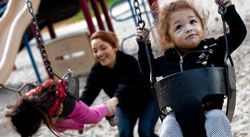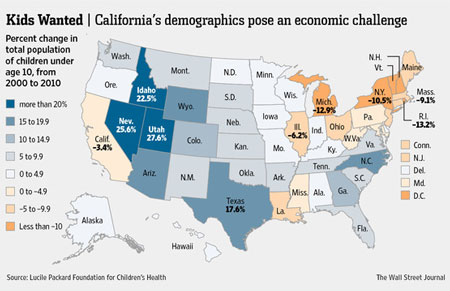redo Jump to...
print Print...
 (Miriam Jordan, The Wall Street Journal) – Declining migration and falling birthrates have led to a drop in the number of children in California just as baby boomers reach retirement, creating an economic and demographic challenge for the nation’s most populous state.
(Miriam Jordan, The Wall Street Journal) – Declining migration and falling birthrates have led to a drop in the number of children in California just as baby boomers reach retirement, creating an economic and demographic challenge for the nation’s most populous state.
“After decades of burgeoning population and economic growth…the state now faces a very different prospect,” said a report released Tuesday by the University of Southern California and the Lucile Packard Foundation. The report, “California’s Diminishing Resource: Children,” …concluded that the trend marks a “historic transition” for the state.
In 1970, six years after the end of the baby boom, children made up more than one-third of California’s population. By 2030, they will account for just one-fifth, according to projections by lead author Dowell Myers, a USC demographer. “We have a massive replacement problem statewide,” Mr. Myers said in an interview.
California’s demographic shift mirrors that of many Northeast and Midwest states, including New York, Massachusetts, Illinois and Michigan, where the percentage of children fell even more sharply from 2000 to 2010. But unlike those states, California has always relied on migrants from other states and abroad to fuel its economy, and the change represents a new reality for the Golden State.
Ever since the Gold Rush (1848-1860), the majority of Californians has been born elsewhere. That pattern began to change in the 1990s, when migrants were attracted by the lower cost of living and rapid growth in other Western and Southern states. Then, the housing bust and 2008 financial crisis hit California harder than most states. By 2010, more than half of all adults 25 to 34 years old were born in California.
At the same time, the state’s birthrate fell to 1.94 children per woman in 2010, below the replacement level of 2.1 children, according to the study. California’s rate is lower than the overall U.S. rate of 2.06 children in 2012, according to the Central Intelligence Agency.
The shrinking pool of youngsters coincides with a bulging population of older people. Nationally, “we are approaching a period of very large retirement, something like two million people a year for the next 20 years,” said Stephen Levy, director of the Center for Continuing Study of the California Economy, an independent research group.
In 1970, California averaged 21 seniors for every 100 working-age adults. By 2030, that ratio is expected to rise to 36 seniors per 100 working-age adults, according to the report. That retirement wave will place “massive pressure on institutions and programs for an aging population [social security, medicare, etc.],” the report said. Today’s children will be the workers who pay for those programs…
“Unless the birthrate picks up, we are going to need more immigrants. If neither happens, we are going to have less growth,” said Mr. Levy. The report wasn’t optimistic, saying that “with migration greatly reduced…outsiders are much less likely to come to the rescue.”
Investments in the state’s education system will be vital to meet labor-force needs and prevent the economy from contracting, said Mr. Levy. With less migration to the state, the skills and human capital necessary to keep California’s economy afloat will need to be homegrown, both Mr. Levy and Mr. Myers said.
With more than 90% of the state’s children under age 10 born in the state, “the majority of the next generation of workers will have been shaped by California’s health and education systems,” Mr. Myers said. “It’s essential that we nurture our human capital.” …
The report found that the birthrate had tumbled for every population group. In 2010, it was below replacement level for whites, Asians and African-Americans.
The birthrate for Hispanics, who account for 51% of children under 18 in the state, was slightly above replacement level. But Hispanic birthrates are seeing the steepest drop of any group and are expected to fall to the replacement level in 2020, the report said.
NOTE: This article was first published at wsj.com on Jan. 8th.
Copyright 2013 Dow Jones & Company, Inc. All Rights Reserved. Reprinted here for educational purposes only. Visit the website at wsj.com.
Questions
1. How will the percentage of children in California’s population change between 1970 to 2030?
2. Describe the 3 factors which have contributed to the decline in the percentage of children in California’s population. Be specific.
3. How is a decline of children going to hurt the economy of California? Be specific.
4. States in the Northeast and Midwest have lost even more children. Why will the reduction affect California more than these others?
5. Why did the number of California’s population born elsewhere begin to decline in the 1990’s?
6. How has the number of California’s seniors compared to working adults changed from 1970 to 2030?
b) How will this affect the economy?
7. Demographer Dowell Myers explained that with more than 90% of the state’s children under age 10 born in the state, “the majority of the next generation of workers will have been shaped by California’s health and education systems,” and says the solution to the declining number of children is to “nurture our human capital.” What do you think of Mr. Myers’ proposed solution?
Background
What the report on less children in California means:
California is producing too few children to supply the workers and taxpayers it will need tomorrow. This deficit, coupled with California’s fast-growing number of aging retirees, bodes ill for the state’s economic future.
The author of the report told ABC News that California’s dearth of children could produce unexpected consequences. These could include further reductions in state pensions (there won’t be enough future tax payers to support future benefits) or a slump in real estate prices: When the moment comes for older homeowners to sell, there may not be enough younger buyers to buy, depressing prices.
What can California do to forestall these and other problems? Not a whole heck of a lot, the study concludes, limiting its attention to children already in the state.
The best California can do is to make life better for its home-grown youngsters by seeing that they get the very best in education, health-care and job training: “Every child must have the necessary support and opportunities to become a maximally contributing member of society,” according to the report.
Other options include: a state tax-credit for couples having children, or regulatory changes that would make moving to California more attractive for a young couple deciding where to raise a family. (Texas has created a more favorable business climate and, in some places, provided better schools. The result is that Texas has posted an increase of 578,000 kids during the same time California has lost 180,000.) [from a Jan. 6 ABCNews story]
Daily “Answers” emails are provided for Daily News Articles, Tuesday’s World Events and Friday’s News Quiz.




